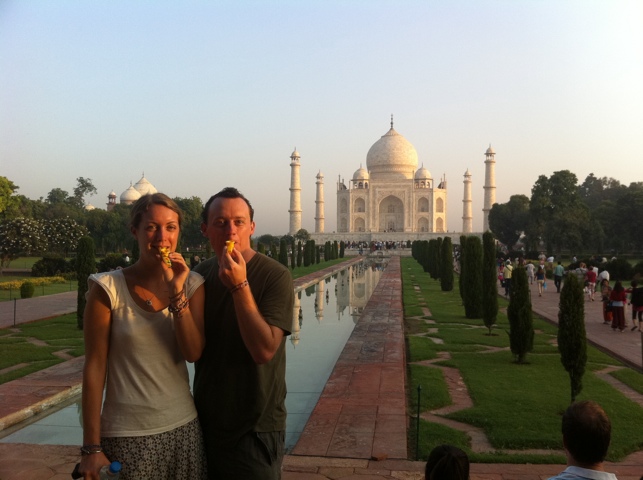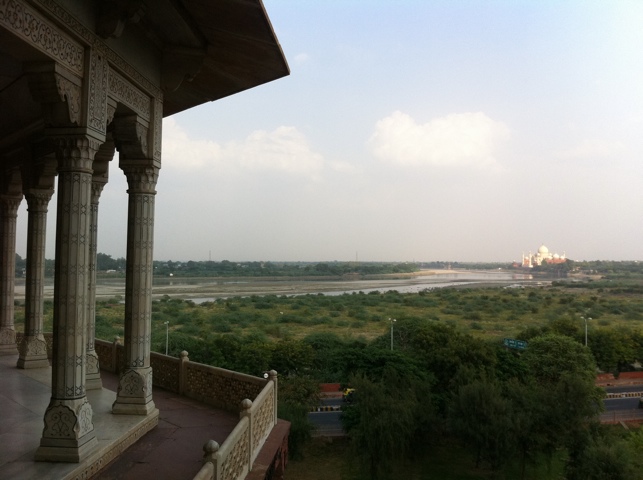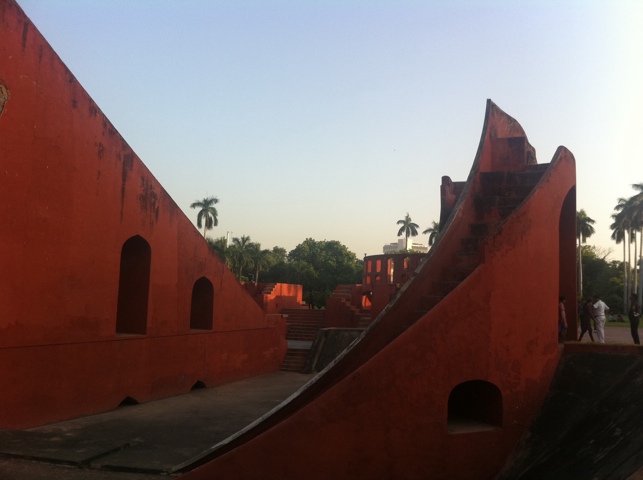In Agra we sought refuge at the delightful Tourists’ Rest House, an oasis of calm from the dusty chaos outside. My food poisoning went from uncomfortable to feverish and there were certainly a few moments when we seriously considered finding the next flight to tamer Thailand! We persevered though and are all the better for it now.
Agra’s a funny unstructured town, without anything in the way of a centre – there are a few different districts which have streets with more shops on, and lots of dusty roads packed with blaring traffic and a blazing sun – but nothing that really feels like you’re somewhere other than a thoroughfare. Fortunately, we found shelter from the heat at a great ice cream parlour near our guest house, where Laura indulged in a chocolate ice cream fantasy – the first frozen stuff we’ve had since setting out. It looked mouthwatering, but I was firmly staying away from anything other than rice and plain toast for the time being!
Our lovely friends Solveig and Gardar from Norway who we met on the Gap tour in China were in Agra at the same time, and so a real highlight was the happy reunion we had with them over rooftop drinks at sunset and then dinner. They regaled us with tales of their recent trip to Sikkim and Butan, a mountain kingdom that’s on the cusp of modernisation after only recently being opened to outsiders. It sounds like a fascinating country, with the Gross National Happiness index (no, really!) taking precedence over more materialistic measures like GDP. They were also near Sikkim when the recent earthquake struck, entertainingly driving down a road at the time that was so bumpy that they didn’t notice the ground shake – but they saw some of the destruction in the places they were staying.
Solveig is also a nurse in her life outside travelling and very kindly provided drugs and rehydration salts to a somewhat out-of-it Simon. Many thanks for that – I’m feeling so much better now!
While we were there, Agra (and indeed India) also played host to Durga Puja, a colourful street festival in which almost every street erects an ornate tented shrine to the goddess Durga. These were on every corner, and ‘tented’ doesn’t really do it justice – this is no marquee. I initially thought some of them were carved from wood, so ornate is the shape of the stretched fabric covering. A great time for celebration – with loud music blaring out of speakers everywhere (including mounted on every telegraph pole down some main roads), festoon lights in red and yellow, and on one of the days, scores of people parading the goddess through the streets, awash with brightly coloured tikka in red, and green, orange and pink.
We visited the Mughal Agra fort, decked in red sandstone with dominating twenty metre high walls. Slightly less impressive was the stench of stagnant water from the putrefying moat – although it certainly encouraged us to pay up and go in quickly! Much like the fort in Delhi, it was a former seat of government, holding a palace and the halls of public and private audience, which were suitably majestic and regal. It also held some features for the amusement of the royals – the ‘fish palace’, with tanks and water channels which could be used to practice fishing, and a (literally) life sized ‘pachisi board’, where the emperor could play the ludo-like game with slave girls dressed in bright colours as the pieces. His father started this practice, and was known to play games with up to 200 ‘pieces’ that would last 3 months! Now I know they say cricket can take quite a long time to play, but I think this takes the record!
Our final sight in Agra was the magnificent Taj Mahal, which more than met its billing, even at the just-after-dawn time of 6:30 in the morning. Majestic, beautiful, tranquil and intricate, its lines of dazzling white symmetry and perfect reflecting pools are a sight that will stay with us for a long time. One cannot help but be awed by the combination of finely carved marble, glowing a pearly white in the morning sun, set against dark place Koranic inscriptions, and all against a huge blue expanse of sky.
The dedication to symmetry is everything – identical left-to-right as well as of course vertically through reflection in the water. The consequence of this is interesting too – the large mosque to the left of the Taj faces Mecca to the west, but of course the replica to the right cannot as it would break the symmetry – so it remains just an empty replica, perhaps a metaphorical place of worship for those who seek aesthetic rather than religious enlightenment.
The Taj Mahal has been described as “a teardrop on the face of eternity”, but to me, the saddest thing about this mausoleum of love comes from its minor piece of asymmetry. For next to the perfectly aligned tomb of Mumtaz Mahal lies the mispositioned and asymmetric resting place of her husband and creator of the Taj, Shah Jahan. He spent his final years deposed and a captive of his own son, only able to gaze upon his romantic monument from the Agra fort in the distance, and then buried awkwardly for eternity – appropriately alongside his greatest love and within his greatest creation – but in a way that he never can have intended or desired. But then when you think about it in the broader sense, what more fitting way can there be to cap off a monument to the trials of love?
Simon





